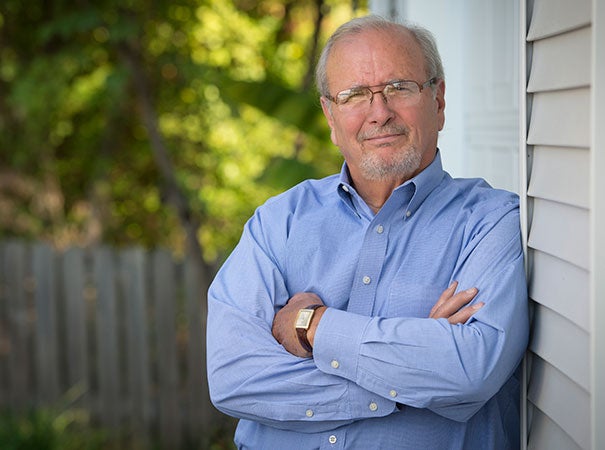Interview with industry veteran Leo Gehring
 |
| PHOTO BY JASON BURT Leo M. Gehring, CHFM, CHC, FASHE, and a 40-year veteran in health care facility management. |
As health care changes how and where services are delivered, facility managers need to stay involved in the transition or risk being left out of the decision process says Leo M. Gehring, CHFM, CHC, FASHE, a 40-year veteran in health care facility management.
What are the biggest challenges facing health care facility managers today?
We may have become a field of mostly left-brained facility managers working in an increasingly right-brained world. What I mean is that the way we conducted our business in the past was centered more on the facility management and construction part of the work than on how our work impacts the overall patient care mission. The impact of our service is becoming more subtle and with a wider impact.
What we have to do is retain those engineering and left-brained skills, but also develop a holistic brain, an artistic brain that's going to help us understand that it is a much different world from what facility managers have been used to in the past.
We still tend to think that we need to build something that is battle-hardened and has all the bells and whistles of traditional hospitals when a lot of patient care is moving into nontraditional environments like retail spaces.
How will the move to population health management and community-based health care impact facility design?
People don't want to go to hospitals anymore. They want to get their health care close to home. We have to start thinking how we will facilitate the delivery of health care wherever it is needed, not how we build these monuments to the inefficiencies of health care.
Of course, we still need hospitals. But there will be fewer of them and each one will need fewer beds. The challenge for the facility manager is to understand design and construction and, at the same time, understand the new spectrum of the health care built environment world.
Are facility managers going to become more involved in the real estate side of facility management?
Some are and I hope most will be in the future. The alternative is that if the facility manager does not understand the retail real estate market or how to work in that world, the hospital will work with a developer or a real estate agent and leave the facility manager out of the picture.
The facility manager will have to make sure the space is compliant even if he or she is not involved in the acquisition process.
So, does this require developing a new set of skills or just making sure that they're involved in the process?
Both. Facilities managers need to have open minds and think strategically about how their institutions have identified a space or location to offer health services.
The facility manager needs to perform due diligence on proposed developments and advise top leadership on the pluses and minuses of a proposal. He or she needs to be able to report findings to leadership in a professional manner that assists developing the proposed initiative to expand space for health care services.
The second thing facility leaders have to learn is how real estate works in general. They don't need to become real estate agents, but they have to understand how real estate development works, and how property acquisition and pricing work in the commercial world.
What are the top objectives for health care facilities leaders in the coming years?
First, we have to provide a more efficient energy posture. Of course, that drives right to the bottom line of the institution and gets to the health of our planet.
Second, I would say that in the planning, design and construction process, we have to become the advocate for efficient workflow. One thing that I still see is new hospitals with large nurses' stations. That's a mistake that will be paid for many times over the life of a facility by creating workflow problems. The correct model is to build decentralized stations so that a nurse is responsible for two or three patients.
The third thing we need to advocate for is the safety of the environment. For example, something as simple as how patient rooms are designed actually may save lives, improve efficiency and reduce infections. Current research shows that if every patient room is constructed the same, then training staff becomes less of an issue and hand-washing compliance increases along with work efficiencies.
What should be the role of the facilities manager?
Facility managers must be a strategic resource that hospital leadership can look to for a wide variety of skills that aid in strategic decision-making. We need to demonstrate that we're willing to listen, to utilize our knowledge and understanding, and be invested in the overall success of the institution.
As facility management, we're generally seen as a cost center. We need to change our perspective and work to become an investment center. We have the talent and we can bring a higher level of knowledge and experience to find facility solutions.
What are common mistakes made in health care planning, design and construction?
The biggest mistake we make is not getting involved in design and construction projects early enough. By getting involved in projects early, we can bring our unique experience and talent to the project so we have an impact. There are facility managers who are doing this well, but there are many who are not.
Facility leaders have to be involved at the beginning of a project to make sure that the preconstruction risk assessment is done. The assessment is required by the Joint Commission and Facility Guidelines Institute.
The planning phase of a project arguably is the most important phase and evaluates all the risks and opportunities. In addition, the planning phase looks at those actions that might shut down during a project and makes sure they are planned for in a safe, efficient manner.
Most hospitals do not do this well at all. They don't even think about conducting the risk assessment until construction is underway. This means that we open ourselves up to safety breaches and additional expenses because the necessary actions were not designed into the process.
The second mistake commonly made is with the program narrative which, again, is required by the Facility Guidelines Institute and the Joint Commission. The program narrative documents what you are going to build before the plans are drawn.
Unfortunately, what happens is that others sometimes start running the project without adequate preplanning. The project can get into trouble financially. We cannot forget about taking care of the basics of what would make a safe, effective health care facility.
Do you see the popularity of modular construction continuing?
I think it's a great idea. You are seeing more and more of it and it's had a natural evolution from hospital construction to major medical centers being built that way. A hospital can provide the design of a patient room and ask for 200 exactly like it. All rooms can be built in a factory without the impact of weather and other disruptions.
We no longer have the luxury of taking five years to build a hospital — that's insane. Every year that it's not built and ready for service is revenue not being generated. Modular construction is absolutely the way to go.
Where do you see the next generation of health care facilities leaders coming from?
We need to start building long-term, constructive partnerships with academia to help build health care facility management programs. To me, the key to the kingdom is getting colleges to develop the programs that will produce students educated for this field. We can't sit back and complain because young people aren't coming to us as their career choice. Every one of us must become invested in finding our replacements.
Second, we have to offer paid internships from a central source that enables the coordination of the process. Many students make their career choice based on the availability of an internship. Many organizations are providing internships now and that is great. Unfortunately, many are not.
Jeff Ferenc is senior editor of Health Facilities Management.
The Leo M. Gehring File
CV
• Principal, Gehring Health Facility Resources, Little Rock, Ark.
• President, Healthcare Institute, an Alliance partner of International Facility Management Association, Houston
• Adjunct instructor, Healthcare Facilities Leadership at Owensboro (Ky.) Community and Technical College
• Lead faculty, American Society for Healthcare Engineering (ASHE), Chicago
Accomplishments
• Vice chancellor for campus operations at the University of Arkansas for Medical Sciences until retirement
• Director of facilities management for the University of Chicago Hospitals
• Past president of the Arkansas Association for Hospital Engineering
• Past president of ASHE
• Retired from U.S. Army at the rank of Chief Warrant Officer 3, Medical Service Corp.
Education
• Chaminade University, bachelor's degree, business
• Colorado Technical University, associate of science degree, biomedical engineering technology




